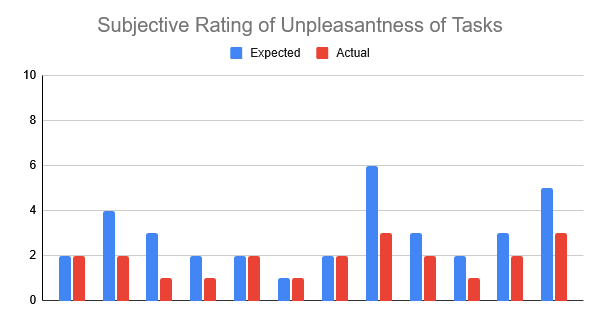Published on July 28, 2025 8:54 PM GMT
Have you ever been endlessly procrastinating on some task, but then once you eventually, finally do it, you realize that it is not half as bad as you thought?
Somehow, many of us keep overestimating how unpleasant it will be to engage with certain types of work to a degree where we put them off for months, building up guilt and resentment, when ultimately all we needed to have done was to grapple with some minor inconvenience.
On the other side, many of us know the feeling of having some drive to continue a thing once we've started it, even though it's supposedly unpleasant. I can dread doing my taxes for months, yet once I set a 5-minute timer to start working on them and get over that initial little hump, the sound of the timer causes disappointment in me rather than elation.
I think there are two primary issues here:
- Our brains somehow manage to maintain a horrendous level of calibration when it comes to predicting how unpleasant it will be to engage with aversive tasksIt's easy never to build a habit of just starting unpleasant things to overcome that initial aversion
Fortunately, there's a simple intervention that can potentially address both of these issues.
The Procrastination Drill
The idea is pretty straightforward: you deliberately spend time starting to engage with aversive tasks over and over again, for short bursts of time. Additionally, you take notes on both your prediction of how unpleasant each task will be and your actual experience.
I suggest to proceed as follows:
- Take some undisrupted time, say an hour.Make a list of tasks you find aversive, or have put off doing for some time for other reasons. I suggest using https://www.randomlists.com/random-picker - just type the list into the text box, one per line, and you'll be able to pick randomly from that list.For the duration of your session, repeat the following:
- Pick one of your tasks randomlyNote down your prediction of how unpleasant working on that task will be, and whySet a short timer to work on the task. Either something like a 3 minute timer[1], or, for extra spiceyness, a more random or Poisson timer such as this one: https://www.jacobh.co.uk/poissontimer/ (just put the desired average duration in seconds into the text box; when it's over, you hear a sound)Work on the task until the timer goes offTake a quick note how unpleasant it actually was to work on the task
First and foremost, going through this many times may build a habit of actually starting rather than procrastinating. Within this hour, you can easily reach 10-15 repetitions of seeing an aversive task in front of you and just going for it rather than looking for excuses for why now is not the right time to do it.
Secondly, by taking notes on how unpleasant you expect the tasks to be and how unpleasant your actual experience is, you may learn something new. When I first went through this, I leanred two things:
- Even when making the initial estimates, I was often surprised how low the numbers were (rating expected unpleasantness from 0 to 10). In the months prior, while I was avoiding many of these tasks, it was easy to associate them with some vague but strong feeling of aversion. But actually thinking things through and putting a number on it, the average number I assigned during my first drill was merely 2.9/10 - much less than I would have expected beforehand.My actual experience was even less bad. My assigned numbers here averaged 1.8/10. Engaging with these tasks was, for the most part, completely fine!

What's more, I was indeed often disappointed or annoyed by the random timer going off, sometimes even ignoring it to continue working on the given task for at least a few more minutes. This went as far as me rewarding myself after being done with the session by continuing to work on one of the tasks I started. A rather paradoxical experience!
Of course, your mileage may vary. Maybe you don't suffer from the underlying issues as much, or maybe this exercise just doesn't do much for you - but I suspect for some people it can be eye-opening. So, if you've never done this kind of exercise before, trying it once may be worth a shot.
- ^
The ideal duration may depend on the nature of your tasks, but I suggest to keep it short. The idea here is not to actually get much done, but to practice starting. In that sense it's also different from resolve cycles, even though the format is somewhat similar.
Discuss

